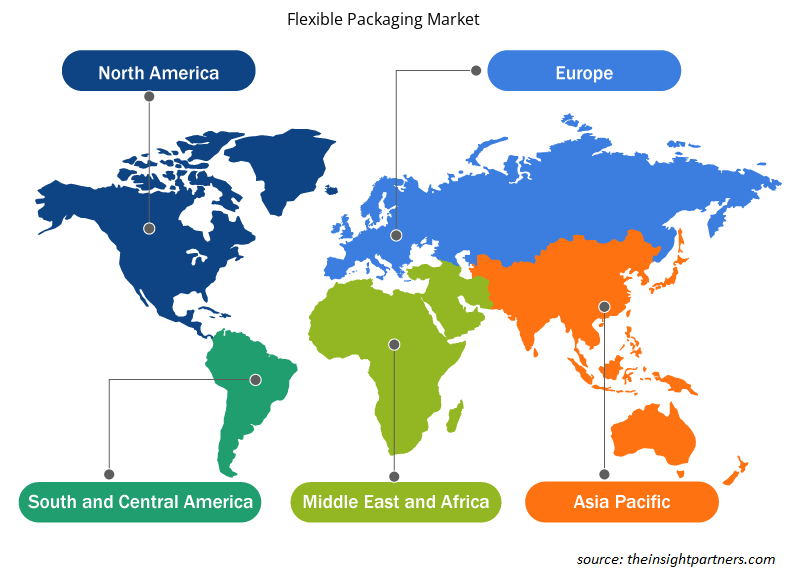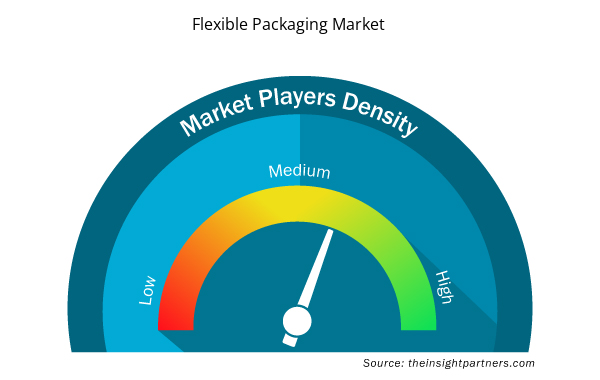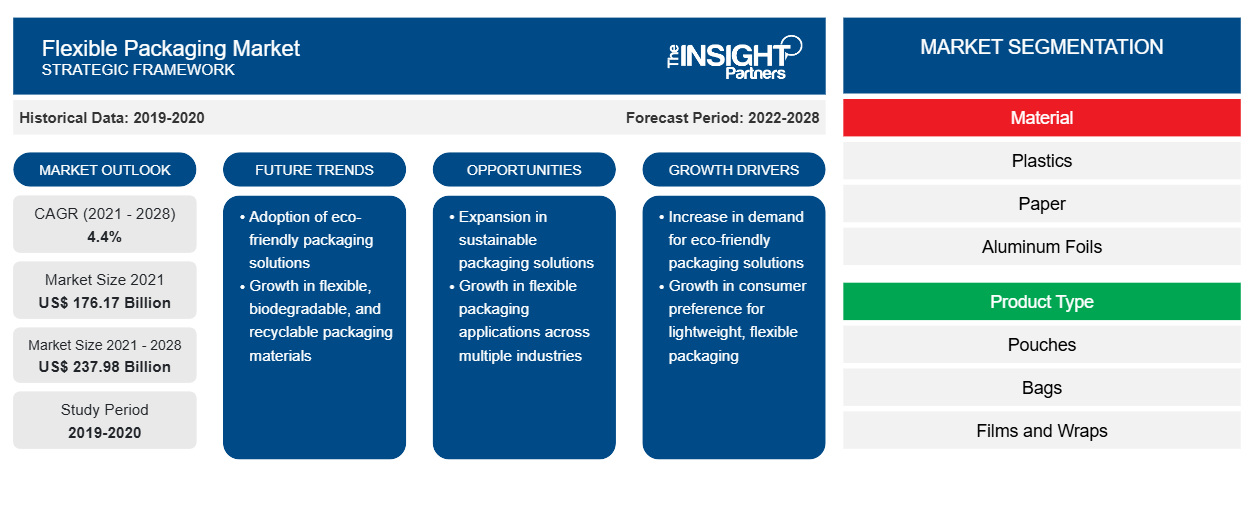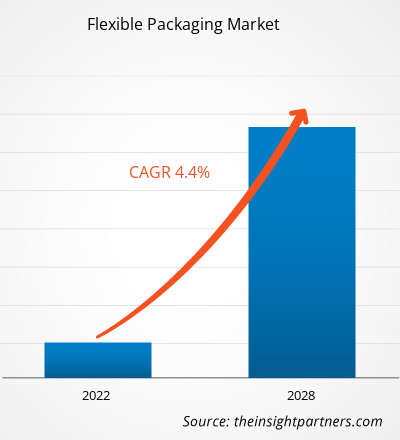유연 포장 시장 규모는 2021년 176,173.61백만 달러에서 2028년 237,975.67백만 달러로 성장할 것으로 전망되며, 2021년에서 2028년까지 연평균 성장률 4.4%로 성장할 것으로 예상됩니다.
유연한 포장에는 라이너, 파우치, 씰, 샘플 패킷 및 백이 포함됩니다. 필름, 플라스틱, 종이, 호일 등으로 구성될 수 있습니다. 다양한 식품 및 음료 품목, 소비자 제품, 음악 CD, 의약품, 컴퓨터 소프트웨어 패키지 및 건강 보조 식품에 사용됩니다. 유연한 포장이 제공하는 내구성 덕분에 제조업체는 눈길을 끄는 고품질의 맞춤형 디자인을 인쇄할 수 있어 소매점에서 제품 가시성이 높아집니다.
2020년 아시아 태평양 지역은 글로벌 유연 포장 시장 에서 가장 큰 매출 점유율을 차지했습니다 . 아시아 태평양 경제 협력체에 따르면 호주는 APAC에서 선진국 중 하나입니다. 식음료 부문은 호주에서 가장 큰 제조업으로, 국가 전체 제조업 매출의 32%를 차지합니다. 호주 식품 및 식료품 협의회의 2019년 산업 현황 보고서에 따르면, 식음료, 식료품, 신선 농산물 부문의 가치는 853억 2천만 달러입니다. 이 산업은 273,000명 이상의 직원을 고용하는 모든 규모의 15,000개 기업으로 구성되어 있습니다. 성장하는 식음료 산업이 유연 포장 시장을 주도합니다.
귀하의 요구 사항에 맞게 이 보고서를 사용자 정의하세요
이 보고서의 일부 또는 국가 수준 분석, Excel 데이터 팩을 포함하여 모든 보고서에 대한 사용자 정의를 무료로 받을 수 있으며 신생 기업 및 대학을 위한 훌륭한 혜택과 할인 혜택을 이용할 수 있습니다.
- 이 보고서의 주요 시장 동향을 알아보세요.이 무료 샘플에는 시장 동향부터 추정 및 예측까지 다양한 데이터 분석이 포함됩니다.
COVID-19 팬데믹이 유연 포장 시장에 미치는 영향
제조 단위의 폐쇄, 원자재 조달의 어려움, 물류 제한은 유연 포장 시장에 부정적인 영향을 미쳤습니다. 그러나 COVID-19로 인해 온라인 식료품 배달이 엄청나게 급증했습니다. 또한, 포장 식품 및 음료 산업은 소비자들이 식료품 저장실을 비축하기 위해 서두르면서 유제품을 포함한 상온 보관 식품 및 음료에 대한 수요가 급증하고 있습니다. 수백만 가구가 픽업 또는 집 배달을 위해 온라인으로 식료품을 구매하기 시작했으며, 많은 가구가 위기가 지난 후에도 전자 상거래 옵션을 계속 사용할 것입니다. 또한, 일반적으로 유통기한을 늘리기 위해 고차단성, 프리미엄 포장재를 사용하는 편의성 지향 식품과 같은 가공 식품에 대한 수요가 증가함에 따라 유연 포장에 대한 필요성이 높아질 것으로 예상됩니다.
시장 통찰력
가공식품 및 음료 소비 증가
Anu Food Brazil 보고서에 따르면, 브라질 식품 소매 부문의 총 수익은 2019년에 960억 달러였습니다. 브라질의 식음료 산업은 2019년에 6.7%, 2020년에 12.8%의 성장을 달성했습니다 . 브라질에서 냉동 식품 시장이 번창하고 있습니다. 브라질에서 냉동 식품 시장은 중산층의 확대, 구매력 상승, 정규직 근로자 수의 증가로 번창하고 있습니다. 따라서 편의 식품에 대한 소비자 선호도가 증가하면서 유연 포장 시장이 성장하고 있습니다.Anu Food Brazil report, the Brazilian food retail sector’s total revenue was US$ 96 billion in 2019. The food & beverage industry in Brazil achieved growth of 6.7% in 2019 and 12.8% in 2020. The
소재 산업 통찰력
재료에 따라 글로벌 유연 포장 시장은 플라스틱, 종이, 알루미늄 호일, 기타로 세분화됩니다. 플라스틱 부문은 2020년 글로벌 유연 포장 시장에서 가장 큰 점유율을 차지했습니다. 유연 플라스틱 포장은 다양한 제품의 포장에 사용되는 다양한 유형의 플라스틱 소재를 포함합니다. 포장에 사용되는 재료의 유형은 포장할 제품의 용도와 유형에 따라 달라집니다. 일반적으로 폴리에틸렌, 폴리프로필렌, 폴리스티렌, 폴리염화비닐과 같은 플라스틱 소재가 유연 플라스틱 포장에 사용됩니다. 유연 포장은 식품, 음료, 제약 제품 및 여러 소모품을 보존, 유통 및 포장하는 가장 편리하고 경제적인 방법으로 간주됩니다.
글로벌 유연 포장 시장에서 활동하는 몇몇 주요 기업에는 Amcor plc, Huhtamaki, Mondi, Berry Global Inc., Sealed Air, Sonoco Products Company, Coveris, Constantia Flexibles, Flexpak services, Transcontinental Inc.가 있습니다. 이 시장에서 활동하는 기업은 고객 요구 사항을 충족하기 위해 고품질의 혁신적인 제품 제공을 개발하는 데 중점을 두고 있습니다.
유연 포장 시장 지역 통찰력
Insight Partners의 분석가들은 예측 기간 동안 유연 포장 시장에 영향을 미치는 지역적 추세와 요인을 철저히 설명했습니다. 이 섹션에서는 북미, 유럽, 아시아 태평양, 중동 및 아프리카, 남미 및 중미의 유연 포장 시장 세그먼트와 지리에 대해서도 설명합니다.

- 유연 포장 시장에 대한 지역별 특정 데이터 얻기
유연 포장 시장 보고서 범위
| 보고서 속성 | 세부 |
|---|---|
| 2021년 시장 규모 | 1,761억 7천만 달러 |
| 2028년까지 시장 규모 | 2,379억 8,000만 달러 |
| 글로벌 CAGR (2021-2028) | 4.4% |
| 역사적 데이터 | 2019-2020 |
| 예측 기간 | 2022-2028 |
| 다루는 세그먼트 | 재료별로
|
| 포함된 지역 및 국가 | 북아메리카
|
| 시장 선도 기업 및 주요 회사 프로필 |
|
유연 포장 시장 참여자 밀도: 비즈니스 역학에 미치는 영향 이해
유연 포장 시장 시장은 소비자 선호도의 변화, 기술 발전, 제품의 이점에 대한 인식 증가와 같은 요인으로 인해 최종 사용자 수요가 증가함에 따라 빠르게 성장하고 있습니다. 수요가 증가함에 따라 기업은 제품을 확장하고, 소비자의 요구를 충족하기 위해 혁신하고, 새로운 트렌드를 활용하여 시장 성장을 더욱 촉진하고 있습니다.
시장 참여자 밀도는 특정 시장이나 산업 내에서 운영되는 회사나 기업의 분포를 말합니다. 주어진 시장 공간에 얼마나 많은 경쟁자(시장 참여자)가 존재하는지 그 규모나 총 시장 가치에 비해 나타냅니다.
유연 포장 시장에서 활동하는 주요 기업은 다음과 같습니다.
- 암코르 주식회사
- 후타마키
- 몬디
- 베리 글로벌 주식회사
- 밀폐된 공기
면책 조항 : 위에 나열된 회사는 어떤 특별한 순서에 따라 순위가 매겨지지 않았습니다.

- 유연 포장 시장 주요 업체 개요 알아보기
스포트라이트 보고서
- 유연 포장 산업의 진보적 추세는 플레이어가 효과적인 장기 전략을 개발하는 데 도움이 됩니다.
- 선진국과 개발도상국의 시장 참여자들이 채택한 사업 성장 전략
- 2019년부터 2028년까지 유연 포장 시장에 대한 정량적 분석
- 유연 포장에 대한 글로벌 수요 추산
- 산업에서 운영되는 구매자와 공급자의 효율성을 설명하기 위한 포터의 5가지 힘 분석
- 경쟁 시장 시나리오를 이해하기 위한 최근 개발
- 유연 포장 시장 성장을 촉진하고 제한하는 요인과 더불어 시장 동향 및 전망
- 상업적 관심을 뒷받침하는 시장 전략을 강조하여 의사 결정 프로세스를 지원하고 시장 성장을 이끕니다.
- 다양한 노드에서의 유연 포장 시장 규모
- 시장의 세부적인 개요 및 세분화, 그리고 산업 역학
- 성장 가능성이 유망한 다양한 지역의 유연 포장 시장 규모
- 역사적 분석(2년), 기준 연도, CAGR을 포함한 예측(7년)
- PEST 및 SWOT 분석
- 시장 규모 가치/양 - 글로벌, 지역, 국가
- 산업 및 경쟁 환경
- Excel 데이터 세트



Report Coverage
Revenue forecast, Company Analysis, Industry landscape, Growth factors, and Trends

Segment Covered
This text is related
to segments covered.

Regional Scope
North America, Europe, Asia Pacific, Middle East & Africa, South & Central America

Country Scope
This text is related
to country scope.
자주 묻는 질문
The major players operating in the global flexible packaging market are Amcor plc; Huhtamaki; Mondi; Berry Global Inc.; Sealed Air; Sonoco Products Company; Coveris; Constantia Flexibles; Flexpak services; Transcontinental Inc.
In 2020, Asia-Pacific accounted for the largest share of the global flexible packaging market. The market for flexible packaging across Asia-Pacific has witnessed notable growth owing to the rapidly expanding packaging industry, growth of the food retail sector, and rising consumer awareness about sustainable packaging solutions across the region. The foodservice sector in Asia-Pacific is rapidly expanding owing to rapid economic growth, growth of the tourism sector, improving lifestyles of consumers, and rising disposable income levels. The region's food & beverage market is witnessing significant growth due to ample availability of various varieties of functional food and drinks and their growing demand among the millennial population. According to The Annual Report on Catering Industry Development of China 2019 (ARCIDC), China is the second-largest food and beverage economy across the world. The food and beverage revenue in China was over US$ 620 billion in 2018. The report further states that the online sales of food and beverages increased by US$ 44 billion from 2011 to 2017. Hence the growing demand for food & beverage in the region drives the flexible packaging market.
In 2020, the plastics segment accounted for the largest market share. Flexible plastic packaging delivers a wide range of protective properties while ensuring a minimum amount of material being used. It is made from high-grade polymers such as PVC, polyamide, polypropylene, and polyethylene. These polymers are FDA-approved and are contaminant-free. They can take on extreme temperatures and pressures. Furthermore, they also act as a protective layer for the food and beverage by protecting it from micro-organisms, UV rays, moisture, and dust.
The bags segment held the largest share of the market in 2020. These are commonly made of metal foil, plastic, and occasionally, paper. These bags are used in various packaging applications including food products, confectionery products, biscuits, coffee, powdered milk, snacks, etc. Also, these bags are easy for transport, material savings, and repeated use.
In 2020, Asia-Pacific is the fastest-growing region in the global flexible packaging market. According to Asia-Pacific Economic Cooperation, Australia is one of the developed countries in APAC. The food & beverage sector is Australia’s largest manufacturing industry, accounting for 32% of the country’s total manufacturing turnover. According to the Australian Food and Grocery Council’s 2019 State of the Industry Report, the food & beverage, grocery, and fresh produce sector is worth $122 billion. The industry is made up of 15,000 businesses of all sizes that employ over 273,000 people. The growing food & beverage industry drives the flexible packaging market.
The food and beverages segment held the largest share of the market in 2020. Flexible packaging is widely used for packaging food products such as eggs, fresh fruits and vegetables, and salad, among others. Flexible packaging protects products from moisture, UV rays, mold, dust, and other environmental contaminants that can negatively affect the product, thereby maintaining its quality and extending its shelf life. Also, with the growth of online food delivery channels the demand for flexible, affordable, and recyclable packaging is also on a rise.
Trends and growth analysis reports related to Chemicals and Materials : READ MORE..
The List of Companies - Flexible Packaging Market
- Amcor plc
- Huhtamaki
- Mondi
- Berry Global Inc.
- Sealed Air
- Sonoco Products Company
- Coveris
- Constantia Flexibles
- Flexpak services
- Transcontinental Inc.
The Insight Partners performs research in 4 major stages: Data Collection & Secondary Research, Primary Research, Data Analysis and Data Triangulation & Final Review.
- Data Collection and Secondary Research:
As a market research and consulting firm operating from a decade, we have published and advised several client across the globe. First step for any study will start with an assessment of currently available data and insights from existing reports. Further, historical and current market information is collected from Investor Presentations, Annual Reports, SEC Filings, etc., and other information related to company’s performance and market positioning are gathered from Paid Databases (Factiva, Hoovers, and Reuters) and various other publications available in public domain.
Several associations trade associates, technical forums, institutes, societies and organization are accessed to gain technical as well as market related insights through their publications such as research papers, blogs and press releases related to the studies are referred to get cues about the market. Further, white papers, journals, magazines, and other news articles published in last 3 years are scrutinized and analyzed to understand the current market trends.
- Primary Research:
The primarily interview analysis comprise of data obtained from industry participants interview and answers to survey questions gathered by in-house primary team.
For primary research, interviews are conducted with industry experts/CEOs/Marketing Managers/VPs/Subject Matter Experts from both demand and supply side to get a 360-degree view of the market. The primary team conducts several interviews based on the complexity of the markets to understand the various market trends and dynamics which makes research more credible and precise.
A typical research interview fulfils the following functions:
- Provides first-hand information on the market size, market trends, growth trends, competitive landscape, and outlook
- Validates and strengthens in-house secondary research findings
- Develops the analysis team’s expertise and market understanding
Primary research involves email interactions and telephone interviews for each market, category, segment, and sub-segment across geographies. The participants who typically take part in such a process include, but are not limited to:
- Industry participants: VPs, business development managers, market intelligence managers and national sales managers
- Outside experts: Valuation experts, research analysts and key opinion leaders specializing in the electronics and semiconductor industry.
Below is the breakup of our primary respondents by company, designation, and region:

Once we receive the confirmation from primary research sources or primary respondents, we finalize the base year market estimation and forecast the data as per the macroeconomic and microeconomic factors assessed during data collection.
- Data Analysis:
Once data is validated through both secondary as well as primary respondents, we finalize the market estimations by hypothesis formulation and factor analysis at regional and country level.
- Macro-Economic Factor Analysis:
We analyse macroeconomic indicators such the gross domestic product (GDP), increase in the demand for goods and services across industries, technological advancement, regional economic growth, governmental policies, the influence of COVID-19, PEST analysis, and other aspects. This analysis aids in setting benchmarks for various nations/regions and approximating market splits. Additionally, the general trend of the aforementioned components aid in determining the market's development possibilities.
- Country Level Data:
Various factors that are especially aligned to the country are taken into account to determine the market size for a certain area and country, including the presence of vendors, such as headquarters and offices, the country's GDP, demand patterns, and industry growth. To comprehend the market dynamics for the nation, a number of growth variables, inhibitors, application areas, and current market trends are researched. The aforementioned elements aid in determining the country's overall market's growth potential.
- Company Profile:
The “Table of Contents” is formulated by listing and analyzing more than 25 - 30 companies operating in the market ecosystem across geographies. However, we profile only 10 companies as a standard practice in our syndicate reports. These 10 companies comprise leading, emerging, and regional players. Nonetheless, our analysis is not restricted to the 10 listed companies, we also analyze other companies present in the market to develop a holistic view and understand the prevailing trends. The “Company Profiles” section in the report covers key facts, business description, products & services, financial information, SWOT analysis, and key developments. The financial information presented is extracted from the annual reports and official documents of the publicly listed companies. Upon collecting the information for the sections of respective companies, we verify them via various primary sources and then compile the data in respective company profiles. The company level information helps us in deriving the base number as well as in forecasting the market size.
- Developing Base Number:
Aggregation of sales statistics (2020-2022) and macro-economic factor, and other secondary and primary research insights are utilized to arrive at base number and related market shares for 2022. The data gaps are identified in this step and relevant market data is analyzed, collected from paid primary interviews or databases. On finalizing the base year market size, forecasts are developed on the basis of macro-economic, industry and market growth factors and company level analysis.
- Data Triangulation and Final Review:
The market findings and base year market size calculations are validated from supply as well as demand side. Demand side validations are based on macro-economic factor analysis and benchmarks for respective regions and countries. In case of supply side validations, revenues of major companies are estimated (in case not available) based on industry benchmark, approximate number of employees, product portfolio, and primary interviews revenues are gathered. Further revenue from target product/service segment is assessed to avoid overshooting of market statistics. In case of heavy deviations between supply and demand side values, all thes steps are repeated to achieve synchronization.
We follow an iterative model, wherein we share our research findings with Subject Matter Experts (SME’s) and Key Opinion Leaders (KOLs) until consensus view of the market is not formulated – this model negates any drastic deviation in the opinions of experts. Only validated and universally acceptable research findings are quoted in our reports.
We have important check points that we use to validate our research findings – which we call – data triangulation, where we validate the information, we generate from secondary sources with primary interviews and then we re-validate with our internal data bases and Subject matter experts. This comprehensive model enables us to deliver high quality, reliable data in shortest possible time.


 이 보고서에 대한 무료 샘플을 받으세요
이 보고서에 대한 무료 샘플을 받으세요